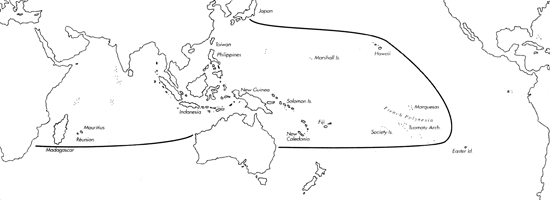
Skip Navigation Links
View access keys for this site.

Range: Entire Indo-Pacific.
Description: Moderately small to moderately large, moderately solid to solid. Last whorl conical or ventricosely conical to broadly and sometimes broadly and ventricosely conical; outline variably convex at adapical third to three-fourths, left side concave below. Shoulder angulate. Spire of low to moderate height, outline slightly convex to concave. Larval shell of 3 or more whorles, maximum diameter 0.6-0.8 mm. Teleoconch sutural ramps flat, with 2-3 increasing to 3-6 spiral grooves. Last whorl with variably prominent fine spiral ribs at base, gradually obsolete adapically.
| Shell Morphometry | ||
|---|---|---|
| L | 30-63 mm | |
| RW | 0.24-0.73 g/mm | |
| (L 30-54 mm) | ||
| RD | 0.59-0.76 | |
| PMD | 0.78-0.90 | |
| RSH | 0.05-0.14 | |
Ground colour bluish white to greyish blue. Last whorl overlaid ?ith various shades of olive, brown or orangish brown, leaving a broad interrrupted spiral ground-colour band below shoulder and another obsolete to broad one at centre. Solid darker brown spiral lines may extend from base to subshoulder area; on some portions of last whorl, brown spiral lines articulated with white dots producing a speckled appearance. Uniformly dark brown shells intergrade with shells with numerous white dots and blotches. Base violet or dark brown. Larval whorls and some adjacent sutural ramps often pale yellow. Later sutural ramps with olive or brown radial markings on white ground. Aperture violet, in large shells variably overlaid with white deep within.
Periostracum yellow to olive, variable in thickness, translucent to opaque, either smooth (Hawaii, India: Kohn, 1959a, 1978a) or with variably spaced tufted spiral ridges on last whorl including shoulder (Natal, Somalia, Philippines, Fiji: Cernohorsky, 1964; Kilburn & Rippey, 1982).
Animal solid black or olive mottled with black. Dorsum of foot may have a short diagonal row of white dots in each anterior corner, sole of foot, rostrum and tentacles may be lighter and siphon may be darker than dorsum of foot (Pl. 75, Fig. 44; Pl. 80, Third row, right) (Kohn, 1959a; Chaberman, pers. comm., 1981; Pearson, unpubl. observ.; Fainzilber et al., 1992).
Radular teeth with an adapical barb opposite a long blade; serration parallels the blade and the base bears a single spur (James, 1980). The tooth depicted by Bandel (1984) for C. semivelatus (Port Sudn, Red Sea) corresponds completely with the preceding description, while that of C. rattus from the same locality appears to be teratological.
Habitat and Habits: On intertidal benches and subtidal reef platforms, to about 15 m, occupying exposed as well as sheltered sites. On benches, it occurs on reef limestone with or without algal turf and in pockets or patches of sand sometimes with sparse vegetation, hiding beneath rocks or corals. On subtidal flats, it lives on bare limestone, limestone with algal turf, coral rubble, dead coral, beach rock with or without sand, in rubble mixed with sand and in pure sand bottom often beneath coral rocks. It is also reported from gravel bottom and from crevices (Kohn, 1959b, 1960, 1968b; Kohn & Nybakken, 1975; Reichelt & Kohn, 1985; Cernohorsky, 1964; Huish, 1978; Kilburn & Rippey, 1982; Grosch, pers. comm., 1989; Tirard, pers. comm., 1989; Fainzilber et al., 1992). C. rattus probably feeds exclusively on polychaete worms within its entire range, usually preferring Eunicidae to Nereidae (Kohn, 1959b, 1960; Kohn & Nybakken, 1975; Reichelt & Kohn, 1985; Marsh, 1971). Its venom is toxic to worms and partially to small fishes but does not affect mice (Endean & Rudkin, 1965). Egg capsules measure 8-15 x 5-11 mm and contain 2,000-7,500 eggs each. In Sri Lanka and the Seychelles, they are deposited in 0.15-1.5 m of water to the underside of coral rocks, affixed by confluent basal plates, and arranged in irregular clusters. Egg diameter of 124-175 µm predicts a minimum pelagic period of 26-30 days (Seychelles, Persian Gulf, India, Sri Lanka, Palau, Hawaii: Ostergaard, 1950; Kohn, 1961b; Perron, 1981b, c; Perron & Kohn, 1985).
Discussion: C. rattus is similar to C. balteatus in shape and colouration of the shell. However, that latter species is distinguished by the tuberculate shoulder of its shell and its brownish red animal. C. rattus could be confused with C. namocanus. However, the latter species attains much larger size, lacks the violet or dark brown base as well as the fine white ?arkings on its last whorl, and has a weaker spiral sculpture on its late sutural ramps. In addition, the foot of C. namocanus is predominantly dull yellow. C. taitensis (Pl. 24, Figs. 22, 23) refers to largely dark brown shells from French Polynesia, but such specimens also occur in Philippines. C. semivelatus (Pl. 24, Fig. 21) refers to a subadult specimen from the Red Sea lacking the extensive white dots and blotches. C. viridis is synonym (see Wils, 1986). However, these specimens co-occur with shells heavily speckled with white (Sharabati, 1984). Smaller subadults from the Red Sea often have a dark violet-blue ground colour anterior to the bluish white subshoulder band and lack the yellow apex.

C. rattus range map
This section contains verbatim reproductions of the accounts of 316 species of Conus from the Indo-Pacific region, from Manual of the Living Conidae, by Röckel, Korn and Kohn (1995). They are reproduced with the kind permission of the present publisher, Conchbooks.
All plates and figures referred to in the text are also in Röckel, Korn & Kohn, 1995. Manual of the Living Conidae Vol. 1: Indo-Pacific Region.
The range maps have been modified so that each species account has it own map, rather than one map that showed the ranges of several species in the original work. This was necessary because each species account is on a separate page on the website and not confined to the order of accounts in the book.
Return to framed version (returns to search page)